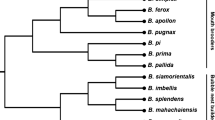Abstract
Canine and human behavior are shaped by similar evolutionary processes, yet the identification of the behavioral phenotype is often difficult. A widely used method relies on breed stereotypes provided by experts such as dog trainers. To reveal a valid association between behavior and genetic factors, an association study of behavioral phenotyping and genotyping is essential. We screened for variable number of tandem repeat (VNTR) polymorphisms in intron 4 of the tyrosine hydroxylase gene in military working dogs (belonging to pass and fail groups based on the results of an in-training examination conducted by the drillmaster), which were scored based on possessiveness, audaciousness, concentration, and motor ability by qualification examination. We first characterized each genotype by sequencing, in which the 1/1 type consists of a single copy of a 36-bp sequence and the 2/2 type is a duplicated form of the 36-bp repeat unit. The 1/2 alleles showed a single nucleotide change as a heteroduplex, which generated a PCR product of similar size as that of the 1/1-182-bp. The military working dogs showed the 2/2 type of VNTR and heteroduplex. For the pass group, two dogs possessed 2/2 type (40 %), whereas three dogs were of the heteroduplex type (60 %). However, all members of fail group showed the 2/2 type (100 %). These data indicate that repeat polymorphisms with behavioral phenotyping can identify military working dogs that would pass or fail the in-training examination.


Similar content being viewed by others
References
Chen HY, Huang W, Leung VHK, Fung SLM, Ma SL, Jiang H, Tang NLS (2013) Functional interaction between SNPs and microsatellite in the transcriptional regulation of insulin-like growth factor 1. Hum Mutat 34(9):1289–1297
Ellegren H (2004) Microsatellites: simple sequences with complex evolution. Nat Rev Genet 5:435–445
Hejjas K, Vas J, Kubinyi E, Sasvari-Szekely M, Miklosi A, Ronai Z (2007) Novel repeat polymorphisms of the dopaminergic neurotransmitter genes among dogs and wolves. Mamm Genome 18:871–879
Hejjas K, Kubinyi E, Ronai Z, Szekely A, Vas J, Miklosi A, Sasvari-Szekely M, Kereszturi E (2009) Molecular and behavioral analysis of the intron 2 repeat polymorphism in the canine dopamine D4 receptor gene. Genes Brain Behav 8:330–336
Irion DN, Schaffer AL, Famula TR, Eggleston ML, Hughes SS, Pedersen NC (2003) Analysis of genetic variation in 28 dog breed populations with 100 microsatellite markers. J Hered 94:81–87
Ishii Y, Takizawa T, Iwasaki H, Fujita Y, Murakami M, Groppe JC, Tanaka K (2012) Nucleotide polymorphism in the canine Noggin gene and their distribution among dog (Canis lupus familiaris) breeds. Biochem Genet 50:12–18
Ito H, Nara H, Inoue-Murayama M, Shimada MK, Koshimura A, Ueda Y, Kitagawa H, Takeuchi Y, Mori Y, Murayama Y, Morita M, Iwasaki T, Ota K, Tanabe Y, Ito S (2004) Allele frequency distribution of the canine dopamine receptor D4 gene exon III and I in 23 breeds. J Vet Med Sci 66:815–820
Kang BT, Kim KS, Min MS, Chae YJ, Kang JW, Yoon J, Chol J, Seong JK, Park HC, An J, Lee MH, Park HM, Lee H (2009) Microsatellite loci analysis for the genetic variability and the parentage test of five dog breeds in South Korea. Genes Genet Syst 84:245–251
Kim KS, Tanabe Y, Park CK, Ha JH (2001) Genetic variability in East Asian dogs using microsatellite loci analysis. J Hered 92:398–403
Kubinyi E, Vas J, Hejjas K, Ronai Z, Brúder I, Turcsán B, Sasvari-Szekely M, Miklósi A (2012) Polymorphism in the tyrosine hydroxylase (TH) gene is associated with activity–impulsivity in German Shepherd Dogs. PLoS One 10:1371
Lit L, Belanger JM, Boehm D, Lybarger N, Haverbeke A, Diederich C, Oberbauer AM (2013) Characterization of a dopamine transporter polymorphism and behavior in Belgian Malinois. BMC Genet 14:45
Litt M, Luty JA (1989) A hypervariable microsatellite revealed by in vitro amplification of a dinucleotide repeat within the cardiac muscle actin gene. Am J Hum Genet 44:397–401
Wan M, Hejjas K, Ronai Z, Elek Z, Sasvari-Szekely M, Champagne FA, Miklósi A, Kubinyi E (2013) DRD4 and TH gene polymorphisms are associated with activity, impulsivity and inattention in Siberian Husky dogs. Anim Genet. doi:10.1111/age.12058
Acknowledgments
This research was supported by awards from the AGENDA project (Project No. PJ009254) in the National Institute of Animal Science, Rural Development Administration (RDA).
Conflict of interest
The authors declare no conflict of interest.
Author information
Authors and Affiliations
Corresponding author
Additional information
Jungwoo Eo and Bong-Hwan Choi have contributed equally to this work.
Rights and permissions
About this article
Cite this article
Eo, J., Choi, BH., Jung, YD. et al. Polymorphism analysis of tyrosine hydroxylase (TH) in military working dogs. Genes Genom 35, 817–821 (2013). https://doi.org/10.1007/s13258-013-0156-7
Received:
Accepted:
Published:
Issue Date:
DOI: https://doi.org/10.1007/s13258-013-0156-7




